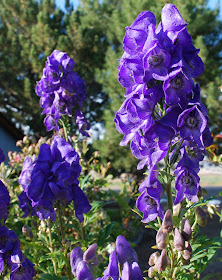Blues are the shy and retiring flowers of the garden. We may not even see them when the reds and yellows shout for attention. Blues must be sought out to be appreciated. They grow most often in the shade and in the spring, but are a welcome addition wherever they are grown.
Phlox Divaricata, the fragrant and fleeting Wild Blue Phlox, is one of the earliest growers in my garden. It spreads slowly, so I dig up starts and plant them at the front of every border where I can find an empty spot. These grow in shade and sun for me, the shade-blooming ones a little later in the season. After blooming, Wild Blue diminishes until you can hardly see her anymore.
Iris Tectorum, the Japanese roof iris, another early bloomer of low growth, grassy leaves and interesting markings.
The prime perennial Rozanne hardy geranium. There never was a better blue, that blooms as long. I've grown lots of geraniums but none as wonderful as this one.
Bobbing butterflies of blue columbine in the spring garden in the company of a peach-pink pillar rose. Men especially like this plant; they always ask what it is and want it in their gardens.
Blue baptisia, the false indigo with its pretty pea flowers and foliage, blooms alongside a white and green ribbon grass.
Delphiniums are the epitome of the sunny blue border flower. I covet these plants, but they never live very long for me. This specimen is one of the more free-flowering species, less well known than the utterly formal and towering Round Table series. Annual larkspur are of the same family, are much less demanding to grow, seed themselves, and come in this same intense blue.
Ruffled blue Scabiosa with white geranium. Slender, lovely plants that seed themselves readily.
One of the many varieties of veronica in my garden. This one is a ground cover with the four-petaled true blue veronica flower. It often reblooms in the fall. I love all veronicas: the tall and slender speedwell, the mid-size candles of white and pink, and the sprawling repens creepers.
Blue balloon flowers of the campanula family, growing in a pot under the Black Lace elderberry, here in frilly flower. The cool blue color is welcome in the hot summer shade garden.
One of the few blues of the mid- to late summer garden, the agastache Blue Fortune puts on a display that few plants can rival
A tall, sturdy, bushy plant, the poisonous Monkshood aconite is also known as wolf's bane, leopard's bane, women's bane, Devil's Helmet or Blue Rocket. Arresting names for an arresting plant.











No comments:
Post a Comment